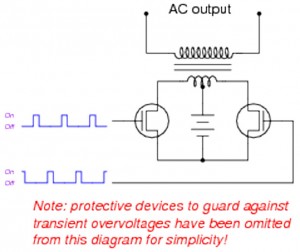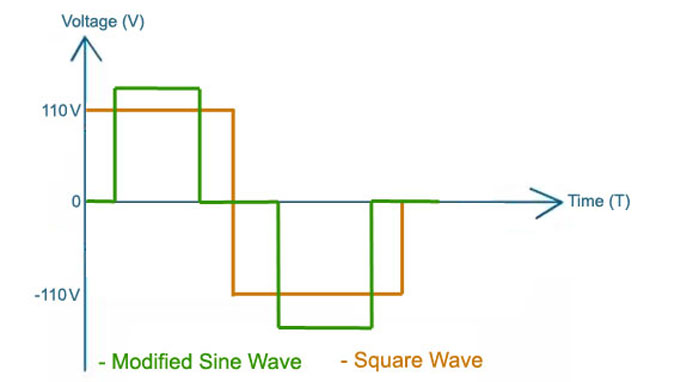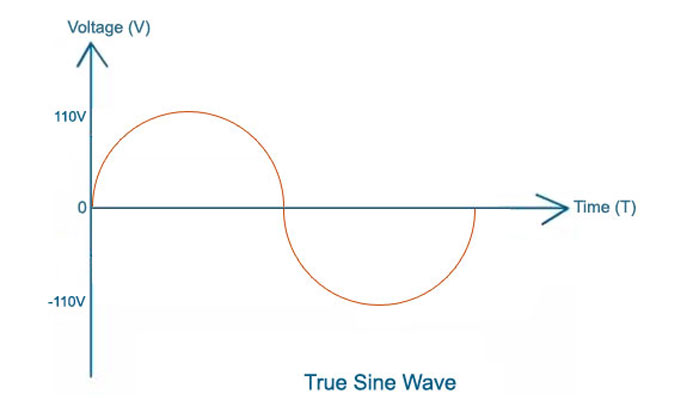What Is An Inverter Used For
What is an Inverter?
An inverter converts the DC voltage to an Air-conditioning voltage. In near cases, the input DC voltage is usually lower while the output AC is equal to the filigree supply voltage of either 120 volts, or 240 Volts depending on the country.
The inverter may be built every bit standalone equipment for applications such as solar power, or to work as a backup power supply from batteries which are charged separately.
The other configuration is when it is a part of a bigger circuit such as a power supply unit, or a UPS. In this instance, the inverter input DC is from the rectified mains Ac in the PSU, while from either the rectified Air conditioning in the in the UPS when there is ability, and from the batteries whenever at that place is a power failure.
At that place are different types of inverters based on the shape of the switching waveform. These have varying excursion configurations, efficiencies, advantages and disadvantages
An inverter provides an air conditioning voltage from dc power sources and is useful in powering electronics and electrical equipment rated at the ac mains voltage. In addition they are widely used in the switched style power supplies inverting stages. The circuits are classified according the switching technology and switch type, the waveform, the frequency and output waveform.
Basic inverter operation
The bones circuits include an oscillator, command circuit, drive circuit for the power devices, switching devices, and a transformer.
The conversion of dc to alternating voltage is achieved by converting energy stored in the dc source such as the battery, or from a rectifier output, into an alternating voltage. This is done using switching devices which are continuously turned on and off, and and so stepping up using the transformer. Although in that location are some configurations which exercise not apply a transformer, these are not widely used.
The DC input voltage is switched on and off by the power devices such as MOSFETs or power transistors and the pulses fed to the primary side of the transformer. The varying voltage in the primary induces an alternate voltage at secondary winding. The transformer likewise works as an amplifier where it increases the output voltage at a ratio determined by the plow's ratio. In virtually cases the output voltage is raised from the standard 12 volts supplied past the batteries to either 120 Volts or 240 volts AC.
The three usually used Inverter output stages are, a button-pull with middle tap transformer, push button-pull half-bridge, or push-pull full bridge. The push pull with middle tap is most popular due to its simplicity and, guaranteed results; however, information technology uses a heavier transformer and has a lower efficiency.
A uncomplicated button pull DC to Air-conditioning inverter with centre tap transformer excursion is a shown in the figure below.

Figure 1 basic inverter switching circuit
Inverter output waveforms
The inverters are classified co-ordinate to their output waveforms with the iii mutual types being the square wave, the pure sine wave and the modified sine wave.
The square wave is unproblematic and cheaper, notwithstanding, it has a low ability quality compared to the other two. The modified foursquare wave provides a better power quality (THD~ 45%) and is suitable for near electronic equipment. These take rectangular pulses that have dead spots between the positive half cycle and the negative one-half bicycle (THD almost 24%).

Figure two: Modified sine waveform
The true sine wave inverter has the best waveform with the lowest THD of nearly 3%. Even so, It is the most expensive and used in applications such as medical equipment, stereos, laser printers and other applications requiring sinusoidal waveforms. These are also used in the grid ties inverters and grid connected equipment

Figure three: Pure Sine wave
Applications
Inverters are used for a diversity of applications that range from pocket-size car adapters to household or office applications, and big filigree systems.
- Uninterruptible power supplies
- Every bit standalone inverters
- In solar power systems
- Equally a building block of a switched fashion power supply
What Is An Inverter Used For,
Source: https://www.sunpower-uk.com/glossary/what-is-an-inverter/
Posted by: curranyoughthears.blogspot.com


0 Response to "What Is An Inverter Used For"
Post a Comment